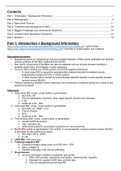Contents
Part 1: Introduction + Background Information...............................................................................................1
Part 2: Pathogenesis..................................................................................................................................... 3
Part 3: Role of the Thymus.......................................................................................................................... 11
Part 4: Treatment and Management of MG.................................................................................................12
Part 5: Biggest Challenges and Unanswered Questions..............................................................................14
Part 6: Lambert-Eaton Myasthenic Syndrome.............................................................................................14
Part 7: Botulism........................................................................................................................................... 15
Part 1: Introduction + Background Information
https://www.ncbi.nlm.nih.gov/pmc/articles/PMC2730933/pdf/nihms132899.pdf = good review
https://www.nature.com/articles/s41572-019-0079-y.pdf = has links to recent papers and evidence
Description/summary:
Myasthenia gravis is a prototypical immune-mediated disorder of NMJ where antibodies are directed
towards proteins of the NMJ, particularly the AchRs
Non AChR components of the NMJ can also be attacked such as tyrosine kinases resulting in
endplate dysfunction and fatigable muscle weakness
As such, MG is divided into AChR-positive and AChR-negative individuals
o In most cases MG is caused by autoantibodies directed towards the skeletal muscle
acetylcholine receptor (AChR) AChR-positive
o In other causes, MG is caused by autoantibodies directed towards muscle-specific receptor
tyrosine kinase (MUSK)
Patients experience skeletal muscle weakness and worsening of receptive activity as a result of this
autoimmune attack
Subgroups
1. Early-onset MG: ocular, ocular-bulbar or generalized
a. HLA DR3, B8
b. Thymic hyperplasia, thymoma, other organ-specific autoimmune diseases
c. F>M
d. AChR ab in 50 – 90%
2. Late-onset MG: ocular, ocular-bulbar or generalized
a. HLA DR2, B7, DRB1 15.01
b. Thymic atrophy
c. M>F
d. AChR ab in 50 – 90%
3. Thymomatous MG: ocular, ocular-bulbar or generalized
a. Usually AChR ab positive
b. Titin, ryanodine ab
c. Other paraneoplastic associations (autoimmune neuromyotonia…
4. MuSK MG: bulbar or generalised (~5% of MG) muscle-specific receptor tyrosine kinase (MUSK)
is the target for the autoimmune attack
a. HLA DQ5, DR14, DR16
b. F>>M
5. LRP4 MG: mild (very rare)
6. Triple-seronegative MG
a. Clustered receptor assay picks up AChR ab in ~50%
b. Agrin, collagen Q
c. Variable association with thymus pathology
7. Drug-induced
a. Immune checkpoint inhibitors (nivolumab, ipilmumab)
i. Often with myositis, sometimes neuropathy, cardiomyositis, hepatitis
ii. Elevated CK, positive AChR labs, anti-titin labs
iii. Also can exacerbate pre-existing MG
, b. Other drugs
8. Transient neonatal MG
a. Passive transfer
b. Self-limiting
Epidemiology
Prevalence ~14 per 100,000
Early peak in incidence F>M
o Historically thought of as a disease of young women
Late-onset MG: M>F
o Raises possibility that causation is different in older age group
o Myasthenia may be underdiagnosed in elderly people – prone to frailness, unfitness –
symptoms of MG
Symptoms and signs
Fatigable weakness
Diurnal fluctuation – much worse in evening than in morning (fluctuates also with exertion)
Affects the eyes – ocular
o Ptosis, varial opthalmoplegia
o Normal pupils – pupils are innervated by muscarinic, not nicotinic receptors
o If pupil is involved, it is not MG
Does NOT affect sensation
Typical presentation: ocular MG
Presenting feature in 50-80%
Variable, fatigable, complex opthalmoplegia
Ptosis + frontalis hyperactivity
Generalises in ~50% within 2 years
o Higher levels of antibodies as they progress
o No clear understanding as to why this happens
Remains ocular in ~15%
Prisms rarely helpful in long term
Typical presentation: bulbar/respiratory
Dysphagia: nasal regurgitation, choking, fatigue on chewing
Fatigable dysarthria
Exertional dyspnoea, nocturnal hyperventilation
Especially common in MuSK MG
Respiratory assessment: Forced Vital Capacity (not peak flow or arterial blood gases) = how much,
not how fast
Some patients experience difficulty swallowing tablets like pyridostigmine
Differential diagnosis
Dysthyroid eye disease
Chronic progressive external opthalmoplegia
Pupil-sparing 3rd nerve lesion
Lambert-Eaton Myasthenic Syndrome
Botulism
Amyotrophic lateral sclerosis
Myopathies
Congenital myasthenic syndromes
Tests
Serology
o Looking for the antibodies that block the AChRs
o Blood test
o Also check thiopurine methyltransferase and thyroid function
Determines ability to metabolise drug used to treat MG
Thyroid antibodies is common and treatable
Clinical neurophysiology




